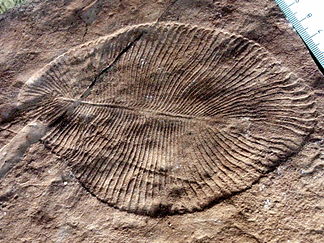Ediacara Hill
| Ediacara Hill | ||
|---|---|---|
|
Dickinsonia costata is a common member of the Ediacara biota. The systematic position is not clearly clarified, but Dickinsonia is mostly regarded as an animal living being |
||
| location | South Australia | |
| part of | Flindersgebirge | |
|
|
||
| Coordinates | 29 ° 48 ′ S , 138 ° 45 ′ E | |
The Ediacara Hills are a range of hills in the north of the Flinders Mountains in the Australian state of South Australia around 350 km north of Adelaide . The first fossil finds of multicellular animals from the Precambrian came in the form of prints in this region . These creatures, which had not yet developed any hard parts that could be preserved and whose systematic position has not yet been clarified, are collectively referred to as the Ediacara fauna .
The Ediacarium , the most recent geological period of the Neoproterozoic, is named after its characteristic soft-body fauna . During this time, the sediments ( pound quartzite ) that make up the Ediacara Hills today were deposited .
History of the discovery of the Ediacaran fauna
The significance of the Ediacara hills for the fossil tradition of multicellular cells and the evolution of life has only been established since the middle of the 20th century. The geologist Reginald Claude Sprigg explored the Ediacara Hills in 1946. There he found imprints of soft organisms that had been preserved mainly on the underside of quartzite and sandstone slabs. It was the first abundant discovery of Precambrian fossils. A few years later, fossils of soft-body organisms were discovered in Leicestershire, Great Britain and Namibia.
Others
Many disused silver and copper mines from the 19th century can be found in the Ediacara Hills.
supporting documents
literature
- Paul Selden and John Nudds: Window on Evolution - Famous Fossil Findings in the World (translated by Jens Seeling), Elsevier Spektrum Akademischer Verlag, Munich 2007, ISBN 978-3-8274-1771-8 .
Web links
Single receipts
- ↑ Selden et al., P. 10

